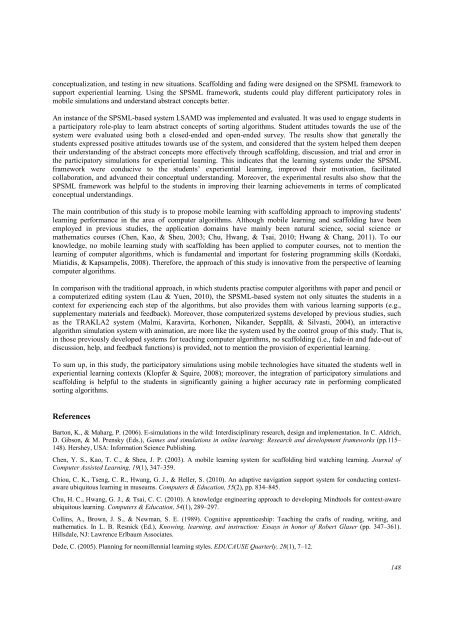Download Complete Issue in PDF - Educational Technology & Society
Download Complete Issue in PDF - Educational Technology & Society
Download Complete Issue in PDF - Educational Technology & Society
You also want an ePaper? Increase the reach of your titles
YUMPU automatically turns print PDFs into web optimized ePapers that Google loves.
conceptualization, and test<strong>in</strong>g <strong>in</strong> new situations. Scaffold<strong>in</strong>g and fad<strong>in</strong>g were designed on the SPSML framework to<br />
support experiential learn<strong>in</strong>g. Us<strong>in</strong>g the SPSML framework, students could play different participatory roles <strong>in</strong><br />
mobile simulations and understand abstract concepts better.<br />
An <strong>in</strong>stance of the SPSML-based system LSAMD was implemented and evaluated. It was used to engage students <strong>in</strong><br />
a participatory role-play to learn abstract concepts of sort<strong>in</strong>g algorithms. Student attitudes towards the use of the<br />
system were evaluated us<strong>in</strong>g both a closed-ended and open-ended survey. The results show that generally the<br />
students expressed positive attitudes towards use of the system, and considered that the system helped them deepen<br />
their understand<strong>in</strong>g of the abstract concepts more effectively through scaffold<strong>in</strong>g, discussion, and trial and error <strong>in</strong><br />
the participatory simulations for experiential learn<strong>in</strong>g. This <strong>in</strong>dicates that the learn<strong>in</strong>g systems under the SPSML<br />
framework were conducive to the students’ experiential learn<strong>in</strong>g, improved their motivation, facilitated<br />
collaboration, and advanced their conceptual understand<strong>in</strong>g. Moreover, the experimental results also show that the<br />
SPSML framework was helpful to the students <strong>in</strong> improv<strong>in</strong>g their learn<strong>in</strong>g achievements <strong>in</strong> terms of complicated<br />
conceptual understand<strong>in</strong>gs.<br />
The ma<strong>in</strong> contribution of this study is to propose mobile learn<strong>in</strong>g with scaffold<strong>in</strong>g approach to improv<strong>in</strong>g students'<br />
learn<strong>in</strong>g performance <strong>in</strong> the area of computer algorithms. Although mobile learn<strong>in</strong>g and scaffold<strong>in</strong>g have been<br />
employed <strong>in</strong> previous studies, the application doma<strong>in</strong>s have ma<strong>in</strong>ly been natural science, social science or<br />
mathematics courses (Chen, Kao, & Sheu, 2003; Chu, Hwang, & Tsai, 2010; Hwang & Chang, 2011). To our<br />
knowledge, no mobile learn<strong>in</strong>g study with scaffold<strong>in</strong>g has been applied to computer courses, not to mention the<br />
learn<strong>in</strong>g of computer algorithms, which is fundamental and important for foster<strong>in</strong>g programm<strong>in</strong>g skills (Kordaki,<br />
Miatidis, & Kapsampelis, 2008). Therefore, the approach of this study is <strong>in</strong>novative from the perspective of learn<strong>in</strong>g<br />
computer algorithms.<br />
In comparison with the traditional approach, <strong>in</strong> which students practise computer algorithms with paper and pencil or<br />
a computerized edit<strong>in</strong>g system (Lau & Yuen, 2010), the SPSML-based system not only situates the students <strong>in</strong> a<br />
context for experienc<strong>in</strong>g each step of the algorithms, but also provides them with various learn<strong>in</strong>g supports (e.g.,<br />
supplementary materials and feedback). Moreover, those computerized systems developed by previous studies, such<br />
as the TRAKLA2 system (Malmi, Karavirta, Korhonen, Nikander, Seppälä, & Silvasti, 2004), an <strong>in</strong>teractive<br />
algorithm simulation system with animation, are more like the system used by the control group of this study. That is,<br />
<strong>in</strong> those previously developed systems for teach<strong>in</strong>g computer algorithms, no scaffold<strong>in</strong>g (i.e., fade-<strong>in</strong> and fade-out of<br />
discussion, help, and feedback functions) is provided, not to mention the provision of experiential learn<strong>in</strong>g.<br />
To sum up, <strong>in</strong> this study, the participatory simulations us<strong>in</strong>g mobile technologies have situated the students well <strong>in</strong><br />
experiential learn<strong>in</strong>g contexts (Klopfer & Squire, 2008); moreover, the <strong>in</strong>tegration of participatory simulations and<br />
scaffold<strong>in</strong>g is helpful to the students <strong>in</strong> significantly ga<strong>in</strong><strong>in</strong>g a higher accuracy rate <strong>in</strong> perform<strong>in</strong>g complicated<br />
sort<strong>in</strong>g algorithms.<br />
References<br />
Barton, K., & Maharg, P. (2006). E-simulations <strong>in</strong> the wild: Interdiscipl<strong>in</strong>ary research, design and implementation. In C. Aldrich,<br />
D. Gibson, & M. Prensky (Eds.), Games and simulations <strong>in</strong> onl<strong>in</strong>e learn<strong>in</strong>g: Research and development frameworks (pp.115–<br />
148). Hershey, USA: Information Science Publish<strong>in</strong>g.<br />
Chen, Y. S., Kao, T. C., & Sheu, J. P. (2003). A mobile learn<strong>in</strong>g system for scaffold<strong>in</strong>g bird watch<strong>in</strong>g learn<strong>in</strong>g. Journal of<br />
Computer Assisted Learn<strong>in</strong>g, 19(1), 347–359.<br />
Chiou, C. K., Tseng, C. R., Hwang, G. J., & Heller, S. (2010). An adaptive navigation support system for conduct<strong>in</strong>g contextaware<br />
ubiquitous learn<strong>in</strong>g <strong>in</strong> museums. Computers & Education, 55(2), pp. 834–845.<br />
Chu, H. C., Hwang, G. J., & Tsai, C. C. (2010). A knowledge eng<strong>in</strong>eer<strong>in</strong>g approach to develop<strong>in</strong>g M<strong>in</strong>dtools for context-aware<br />
ubiquitous learn<strong>in</strong>g. Computers & Education, 54(1), 289–297.<br />
Coll<strong>in</strong>s, A., Brown, J. S., & Newman, S. E. (1989). Cognitive apprenticeship: Teach<strong>in</strong>g the crafts of read<strong>in</strong>g, writ<strong>in</strong>g, and<br />
mathematics. In L. B. Resnick (Ed.), Know<strong>in</strong>g, learn<strong>in</strong>g, and <strong>in</strong>struction: Essays <strong>in</strong> honor of Robert Glaser (pp. 347–361).<br />
Hillsdale, NJ: Lawrence Erlbaum Associates.<br />
Dede, C. (2005). Plann<strong>in</strong>g for neomillennial learn<strong>in</strong>g styles. EDUCAUSE Quarterly, 28(1), 7–12.<br />
148

















